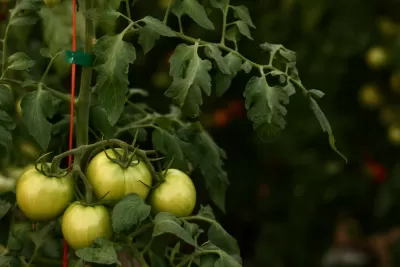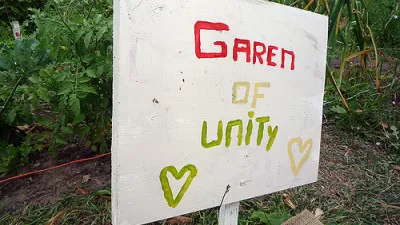The founder of Asante Microfarm hopes his farm will serve as a model for bringing fresh produce to underserved communities.

An urban gardener in Los Angeles has transformed a small front yard into a thriving microfarm, reports Donovan X. Ramsey in the Los Angeles Times. Jamiah Hargins, who started with a backyard garden and swapping produce with neighbors, now manages a farm that "can grow over 600 plants and feed about 50 families."
According to Food Forward Agency Relations Manager Pearson King, Asante Microfarm, housed in a front yard in L.A.'s View Park neighborhood, is "an example of the need for more innovative approaches to food sovereignty that are created by, for, and within the communities that have been systematically and strategically excluded from food production."
To create Asante, "Hargins partnered with a group called Enviroscape LA to map out the irrigation and landscaping" and harnessed a team of volunteers to prepare and cultivate the farm. "The crops grow from nutrient-rich sacks of compost and the whole farm is supported by an irrigation system that not only recycles water but uses just 8% of the water previously used for grass. The farm was built using part of a $50,000 LA2050 grant from the Goldhirsh Foundation but will be sustained by subscriptions that cost $36 per month and $43 with delivery. For that, subscribers get a 3-pound mix of greens and vegetables every week."
Hargins says the Asante Microfarm "is a proof of concept for a much larger goal" to "empower underserved communities while giving them access to fresh food." Eventually, "he hopes to help build and manage 400 microfarms across the city."
FULL STORY: ‘Microfarms’ come to South L.A. frontyards, bringing fresh produce to food deserts

Maui's Vacation Rental Debate Turns Ugly
Verbal attacks, misinformation campaigns and fistfights plague a high-stakes debate to convert thousands of vacation rentals into long-term housing.

Planetizen Federal Action Tracker
A weekly monitor of how Trump’s orders and actions are impacting planners and planning in America.

In Urban Planning, AI Prompting Could be the New Design Thinking
Creativity has long been key to great urban design. What if we see AI as our new creative partner?

Florida Seniors Face Rising Homelessness Risk
High housing costs are pushing more seniors, many of them on a fixed income, into homelessness.

Massachusetts Budget Helps Close MBTA Budget Gap
The budget signed by Gov. Maura Healey includes $470 million in MBTA funding for the next fiscal year.

Milwaukee Launches Vision Zero Plan
Seven years after the city signed its Complete Streets Policy, the city is doubling down on its efforts to eliminate traffic deaths.
Urban Design for Planners 1: Software Tools
This six-course series explores essential urban design concepts using open source software and equips planners with the tools they need to participate fully in the urban design process.
Planning for Universal Design
Learn the tools for implementing Universal Design in planning regulations.
Gallatin County Department of Planning & Community Development
Heyer Gruel & Associates PA
JM Goldson LLC
City of Camden Redevelopment Agency
City of Astoria
Transportation Research & Education Center (TREC) at Portland State University
Jefferson Parish Government
Camden Redevelopment Agency
City of Claremont




























